List of United States Supreme Court cases, volume 193
| Supreme Court of the United States | |
|---|---|
 | |
| Established | March 4, 1789[1] |
| Location | Washington, D.C. |
| Coordinates | 38°53′26″N 77°00′16″W / 38.89056°N 77.00444°WCoordinates: 38°53′26″N 77°00′16″W / 38.89056°N 77.00444°W |
| Composition method | Presidential nomination with Senate confirmation |
| Authorized by | Constitution of the United States, Art. III, § 1 |
| Judge term length | life tenure, subject to impeachment and removal |
| Number of positions | 9 (by statute) |
| Website | supremecourt |
| This article is part of the series on the |
| Supreme Court of the United States |
|---|
 |
| The Court |
|
| Current membership |
|
| Lists of justices |
|
| Court functionaries |
|
|
| Constitutional law of the United States |
|---|
 |
| Overview |
|
| Principles |
|
| Government structure |
|
| Individual rights |
|
| Theory |
|
This is a list of the 44 cases reported in volume 193 of United States Reports, decided by the Supreme Court of the United States in 1904.
Justices of the Supreme Court at the time of volume 193 U.S.[]
The Supreme Court is established by Article III, Section 1 of the Constitution of the United States, which says: "The judicial Power of the United States, shall be vested in one supreme Court . . .". The size of the Court is not specified; the Constitution leaves it to Congress to set the number of justices. Under the Judiciary Act of 1789 Congress originally fixed the number of justices at six (one chief justice and five associate justices).[2] Since 1789 Congress has varied the size of the Court from six to seven, nine, ten, and back to nine justices (always including one chief justice).
When the cases in volume 193 were decided the Court comprised the following nine members:
| Portrait | Justice | Office | Home State | Succeeded | Date confirmed by the Senate (Vote) |
Tenure on Supreme Court |
|---|---|---|---|---|---|---|
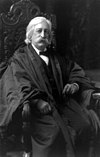
|
Melville Fuller | Chief Justice | Illinois | Morrison Waite | July 20, 1888 (41–20) |
October 8, 1888 – July 4, 1910 (Died) |
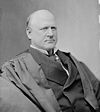
|
John Marshall Harlan | Associate Justice | Kentucky | David Davis | November 29, 1877 (Acclamation) |
December 10, 1877 – October 14, 1911 (Died) |
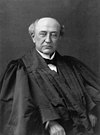
|
David Josiah Brewer | Associate Justice | Kansas | Stanley Matthews | December 18, 1889 (53–11) |
January 6, 1890 – March 28, 1910 (Died) |

|
Henry Billings Brown | Associate Justice | Michigan | Samuel Freeman Miller | December 29, 1890 (Acclamation) |
January 5, 1891 – May 28, 1906 (Retired) |

|
Edward Douglass White | Associate Justice | Louisiana | Samuel Blatchford | February 19, 1894 (Acclamation) |
March 12, 1894 – December 18, 1910 (Continued as chief justice) |
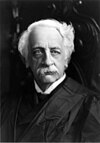
|
Rufus W. Peckham | Associate Justice | New York | Howell Edmunds Jackson | December 9, 1895 (Acclamation) |
January 6, 1896 – October 24, 1909 (Died) |
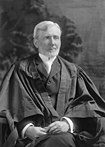
|
Joseph McKenna | Associate Justice | California | Stephen Johnson Field | January 21, 1898 (Acclamation) |
January 26, 1898 – January 5, 1925 (Retired) |

|
Oliver Wendell Holmes Jr. | Associate Justice | Massachusetts | Horace Gray | December 4, 1902 (Acclamation) |
December 8, 1902 – January 12, 1932 (Retired) |

|
William R. Day | Associate Justice | Ohio | George Shiras Jr. | February 23, 1903 (Acclamation) |
March 2, 1903 – November 13, 1922 (Retired) |
Notable Case in 193 U.S.[]

Northern Securities Co. v. United States[]
Northern Securities Co. v. United States, 193 U.S. 197 (1904), is a landmark antitrust decision of the Supreme Court. The Court ruled 5 to 4 against the stockholders of the Great Northern and Northern Pacific railroad companies, who had formed a monopoly under the Northern Securities Company. The public had become greatly alarmed by Northern Securities, which threatened to become the largest company in the world and to corner the railroad traffic in the western United States. The Court's decision was a blow to monopolist James J. Hill, who had helped engineer the formation of Northern Securities, and was a victory for President Theodore Roosevelt's trust-busting activities under the Sherman Antitrust Act. The dissenting opinion of Justice Oliver Wendell Holmes, Jr. included the famous passage: "Great cases like hard cases make bad law. For great cases are called great, not by reason of their real importance in shaping the law of the future, but because of some accident of immediate overwhelming interest which appeals to the feelings and distorts the judgment."
Citation style[]
Under the Judiciary Act of 1789 the federal court structure at the time comprised District Courts, which had general trial jurisdiction; Circuit Courts, which had mixed trial and appellate (from the US District Courts) jurisdiction; and the United States Supreme Court, which had appellate jurisdiction over the federal District and Circuit courts—and for certain issues over state courts. The Supreme Court also had limited original jurisdiction (i.e., in which cases could be filed directly with the Supreme Court without first having been heard by a lower federal or state court). There were one or more federal District Courts and/or Circuit Courts in each state, territory, or other geographical region.
The Judiciary Act of 1891 created the United States Courts of Appeals and reassigned the jurisdiction of most routine appeals from the district and circuit courts to these appellate courts. The Act created nine new courts that were originally known as the "United States Circuit Courts of Appeals." The new courts had jurisdiction over most appeals of lower court decisions. The Supreme Court could review either legal issues that a court of appeals certified or decisions of court of appeals by writ of certiorari.
Bluebook citation style is used for case names, citations, and jurisdictions.
- "# Cir." = United States Court of Appeals
- e.g., "3d Cir." = United States Court of Appeals for the Third Circuit
- "C.C.D." = United States Circuit Court for the District of . . .
- e.g.,"C.C.D.N.J." = United States Circuit Court for the District of New Jersey
- "D." = United States District Court for the District of . . .
- e.g.,"D. Mass." = United States District Court for the District of Massachusetts
- "E." = Eastern; "M." = Middle; "N." = Northern; "S." = Southern; "W." = Western
- e.g.,"C.C.S.D.N.Y." = United States Circuit Court for the Southern District of New York
- e.g.,"M.D. Ala." = United States District Court for the Middle District of Alabama
- "Ct. Cl." = United States Court of Claims
- "Ct. Com. Pl." = Court of Common Pleas (a state court)
- The abbreviation of a state's name alone indicates the highest appellate court in that state's judiciary at the time.
- e.g.,"Pa." = Supreme Court of Pennsylvania
- e.g.,"Me." = Supreme Judicial Court of Maine
List of cases in volume 193 U.S.[]
| Case Name | Page & year | Opinion of the Court | Concurring opinion(s) | Dissenting opinion(s) | Lower Court | Disposition of case |
|---|---|---|---|---|---|---|
| United States v. Northern P.R.R. Co. | 1 (1904) | Fuller | none | none | 9th Cir. | affirmed |
| Carstairs v. Cochran | 10 (1904) | Brewer | none | none | Md. | affirmed |
| Grand Rapids & I. Ry. Co. v. Osborn | 17 (1904) | White | none | none | Mich. | affirmed |
| Cincinnati St. Ry. Co. v. Snell | 30 (1904) | White | none | none | Ohio | affirmed |
| Montague Co. v. Lowry | 38 (1904) | Peckham | none | none | 9th Cir. | affirmed |
| American Book Co. v. Kansas ex rel. Nichols | 49 (1904) | McKenna | none | none | Kan. | dismissed |
| Minneapolis & S.L.R.R. Co. v. Minnesota | 53 (1904) | McKenna | none | none | Minn. | affirmed |
| Ah How v. United States | 65 (1904) | Holmes | none | none | E.D.N.Y. | affirmed |
| Leigh v. Green | 79 (1904) | Day | none | none | Neb. | affirmed |
| Julian v. Central Tr. Co. | 93 (1904) | Day | none | none | 4th Cir. | affirmed |
| United States v. Choctaw Nation | 115 (1904) | McKenna | none | none | Ct. Cl. | affirmed |
| Delaware Indians v. Cherokee Nation | 127 (1904) | Day | none | none | Ct. Cl. | affirmed |
| Giles v. Teasley | 146 (1904) | Day | none | none | Ala. | dismissed for want of jurisdiction |
| Security Land & Exploration Co. v. Burns | 167 (1904) | Peckham | none | none | Minn. | affirmed |
| Security Land & Exploration Co. v. Weckey | 188 (1904) | Peckham | none | none | Minn. | affirmed |
| Winous Point Shooting Club v. Caspersen | 189 (1904) | Fuller | none | none | Ohio | dismissed |
| Hodges v. Colcord | 192 (1904) | Brewer | none | none | Sup. Ct. Terr. Okla. | affirmed |
| Northern Securities Co. v. United States | 197 (1904) | Harlan (plurality) | Brewer | White, Holmes | C.C.D. Minn. | affirmed |
| Eaton v. Brown | 411 (1904) | Holmes | none | none | D.C. Cir. | reversed |
| Underground R.R. v. City of New York | 416 (1904) | Fuller | none | none | C.C.S.D.N.Y. | affirmed |
| Barney v. City of New York | 430 (1904) | Fuller | none | none | C.C.S.D.N.Y. | affirmed |
| Huntington v. City of New York | 441 (1904) | Fuller | none | none | C.C.S.D.N.Y. | affirmed |
| Boering v. Chesapeake Beach Ry. Co. | 442 (1904) | Brewer | none | none | D.C. Cir. | affirmed |
| Gagnon v. United States | 451 (1904) | Brown | none | none | Ct. Cl. | affirmed |
| Tinker v. Colwell | 473 (1904) | Peckham | none | none | N.Y. Sup. Ct. | affirmed |
| Fargo v. Hart | 490 (1904) | Holmes | none | none | C.C.D. Ind. | reversed |
| Rippey v. Texas | 504 (1904) | Holmes | none | none | Tex. Ct. Crim. App. | affirmed |
| Adams v. Church | 510 (1904) | Day | none | none | Or. Cir. Ct. | affirmed |
| Tom Hong v. United States | 517 (1904) | Day | none | none | E.D.N.Y. | reversed |
| Bache v. Hunt | 523 (1904) | Fuller | none | none | C.C.N.D. Ohio | dismissed for want of jurisdiction |
| Yaple v. Dahl-Millikan Grocery Co. | 526 (1904) | Fuller | none | none | 6th Cir. | remanded to divided lower court |
| United States v. Jones | 528 (1904) | Fuller | none | none | Ct. Cl. | affirmed |
| Great S. Fire Proof Hotel Co. v. Jones | 532 (1904) | Harlan | none | none | 6th Cir. | affirmed |
| Mutual Life Ins. Co. v. Hill | 551 (1904) | Brewer | none | none | 9th Cir. | reversed |
| Newburyport Water Co. v. City of Newburyport | 561 (1904) | White | none | none | C.C.D. Mass. | reversed |
| Gloucester Water Supply Co. v. City of Gloucester | 580 (1904) | White | none | none | C.C.D. Mass. | reversed |
| Third Nat'l Bank v. Buffalo German Ins. Co. | 581 (1904) | White | none | none | N.Y. | affirmed |
| United States v. McCoy | 593 (1904) | White | none | none | 9th Cir. | reversed |
| Platt v. Wilmot | 602 (1904) | Peckham | none | none | 2d Cir. | affirmed |
| Sloan v. United States | 614 (1904) | Peckham | none | none | C.C.D. Neb. | dismissed for want of jurisdiction |
| Pope v. Williams | 621 (1904) | Peckham | none | none | Md. | affirmed |
| National Mut. Bldg. & Loan Ass'n v. Brahan | 635 (1904) | McKenna | none | none | Miss. | affirmed |
| United States v. Commonwealth Title Ins. & Tr. Co. | 651 (1904) | McKenna | none | none | Ct. Cl. | affirmed |
| Wright v. Minnesota Mut. Life Ins. Co. | 657 (1904) | Day | none | none | C.C.D. Minn. | affirmed |
Notes and references[]
- ^ Lawson, Gary; Seidman, Guy (2001). "When Did the Constitution Become Law?". Notre Dame Law Review. 77: 1–37.
- ^ "Supreme Court Research Guide". Georgetown Law Library. Retrieved April 7, 2021.
See also[]
- Certificate of division
External links[]
- [1] Case reports in volume 193 from Library of Congress
- [2] Case reports in volume 193 from Court Listener
- [3] Case reports in volume 193 from the Caselaw Access Project of Harvard Law School
- [4] Case reports in volume 193 from Google Scholar
- [5] Case reports in volume 193 from Justia
- [6] Case reports in volume 193 from Open Jurist
- Website of the United States Supreme Court
- United States Courts website about the Supreme Court
- National Archives, Records of the Supreme Court of the United States
- American Bar Association, How Does the Supreme Court Work?
- The Supreme Court Historical Society
- Lists of United States Supreme Court cases by volume
- 1904 in United States case law

